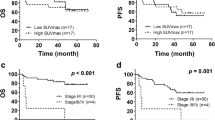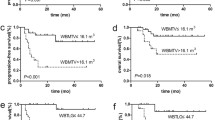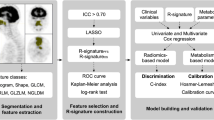Abstract
Objective
Although the prognostic value of positron emission tomography/computed tomography (PET/CT) using [18F]-fluorodeoxyglucose (18F-FDG) has been widely confirmed for diffuse large B cell lymphoma, its value for extranodal natural killer/T-cell lymphoma, nasal type (ENKTL), is still controversial. Therefore, we designed a prospective study to investigate the prognostic value of 18F-FDG PET/CT in patients with ENKTL.
Materials and methods
Thirty-three patients with newly diagnosed, untreated ENKTL, were enrolled in this study. Interim and post-therapy PET/CT scans were analyzed by visual evaluation, in accordance with the criteria set forth by the International Harmonization Project. Patients were classified as either positive or negative. Pretreatment maximum standardized uptake values (SUVmax) of 18F-FDG were recorded in the most 18F-FDG-intense lesions. The pretreatment 18F-FDG SUV as well as the interim and post-therapy PET/CT results were assessed for the ability to predict progression-free survival (PFS) and overall survival (OS).
Results
On the pretreatment scan, the SUVmax of the indicator lesion was >10.00 in 81.8 % of patients who were treatment-resistant and ≤10.00 in 86.4 % of patients who were treatment non-resistant (mean SUVmax, 12.93 and 8.10, respectively). Univariate analyses revealed that pretreatment SUVmax is a significant predictor (P < 0.01, P < 0.01) of PFS and OS, respectively. Multivariate analyses revealed that pretreatment SUVmax (P < 0.01, P = 0.01) and post-therapy PET/CT result (P < 0.01, P = 0.04) are independent predictors of PFS and OS, respectively.
Conclusions
18F-FDG uptakes prior to treatment and post-therapy PET/CT results can predict unfavorable outcomes following treatment in patients with ENKTL, but interim PET/CT results have little value in predicting survival.



Similar content being viewed by others
References
Swerdlow SH. International Agency for Research on Cancer. WHO classification of tumours of haematopoietic and lymphoid tissues. Lyon: International Agency for Research on Cancer; 2008.
Peh SC. Host ethnicity influences non-Hodgkin’s lymphoma subtype frequency and Epstein–Barr virus association rate: the experience of a multi-ethnic patient population in Malaysia. Histopathology. 2001;38:458–65.
Kwong YL, Anderson BO, Advani R, Kim WS, Levine AM, Lim ST, et al. Management of T-cell and natural-killer-cell neoplasms in Asia: consensus statement from the Asian Oncology Summit 2009. Lancet Oncol. 2009;10:1093–101.
Seam P, Juweid ME, Cheson BD. The role of FDG-PET scans in patients with lymphoma. Blood. 2007;110:3507–16.
Kim CY, Hong CM, Kim DH, Son SH, Jeong SY, Lee SW, et al. Prognostic value of whole-body metabolic tumour volume and total lesion glycolysis measured on (1)(8)F-FDG PET/CT in patients with extranodal NK/T-cell lymphoma. Eur J Nucl Med Mol Imaging. 2013;40:1321–9.
Khong PL, Huang B, PhinLee EY, SumChan WK, Kwong YL. Midtreatment 18F-FDG PET/CT scan for early response assessment of SMILE therapy in natural killer/T-cell lymphoma: a prospective study from a single center. J Nucl Med. 2014;55:911–6.
Boellaard R. Standards for PET image acquisition and quantitative data analysis. J Nucl Med. 2009;50(Suppl 1):11S–20S.
Cashen AF, Dehdashti F, Luo J, Homb A, Siegel BA, Bartlett NL. 18F-FDG PET/CT for early response assessment in diffuse large B-cell lymphoma: poor predictive value of international harmonization project interpretation. J Nucl Med. 2011;52:386–92.
Juweid ME, Stroobants S, Hoekstra OS, Mottaghy FM, Dietlein M, Guermazi A, et al. Use of positron emission tomography for response assessment of lymphoma: consensus of the Imaging Subcommittee of International Harmonization Project in lymphoma. J Clin Oncol. 2007;25:571–8.
Cheson BD, Horning SJ, Coiffier B, Shipp MA, Fisher RI, Connors JM, et al. Report of an international workshop to standardize response criteria for non-Hodgkin’s lymphomas. NCI Sponsored International Working Group. J Clin Oncol. 1999;17:1244.
Li YJ, Li ZM, Xia XY, Huang HQ, Xia ZJ, Lin TY, et al. Prognostic value of interim and posttherapy 18F-FDG PET/CT in patients with mature T-cell and natural killer cell lymphomas. J Nucl Med. 2013;54:507–15.
Naumann R, Vaic A, Beuthien-Baumann B, Bredow J, Kropp J, Kittner T, et al. Prognostic value of positron emission tomography in the evaluation of post-treatment residual mass in patients with Hodgkin’s disease and non-Hodgkin’s lymphoma. Br J Haematol. 2001;115:793–800.
Cahu X, Bodet-Milin C, Brissot E, Maisonneuve H, Houot R, Morineau N, et al. 18F-fluorodeoxyglucose-positron emission tomography before, during and after treatment in mature T/NK lymphomas: a study from the GOELAMS group. Ann Oncol. 2011;22:705–11.
Reske SN. PET and restaging of malignant lymphoma including residual masses and relapse. Eur J Nucl Med Mol Imaging. 2003;30(Suppl 1):S89–96.
Kim SJ, Kim WS. Treatment of localized extranodal NK/T cell lymphoma, nasal type. Int J Hematol. 2010;92:690–6.
Brepoels L, Stroobants S, Verhoef G. PET and PET/CT for response evaluation in lymphoma: current practice and developments. Leuk Lymphoma. 2007;48:270–82.
Acknowledgments
This research was supported by the National Natural Science Foundation of China (81471693) and the Sichuan Provincial Department of science and technology support program. (2012SZ0005).
Conflict of interest
The authors declare that they have no conflict of interest.
Author information
Authors and Affiliations
Corresponding author
Additional information
C. Jiang and X. Zhang are co-first authors. They contributed equally to the work.
Rights and permissions
About this article
Cite this article
Jiang, C., Zhang, X., Jiang, M. et al. Assessment of the prognostic capacity of pretreatment, interim, and post-therapy 18F-FDG PET/CT in extranodal natural killer/T-cell lymphoma, nasal type. Ann Nucl Med 29, 442–451 (2015). https://doi.org/10.1007/s12149-015-0964-8
Received:
Accepted:
Published:
Issue Date:
DOI: https://doi.org/10.1007/s12149-015-0964-8




